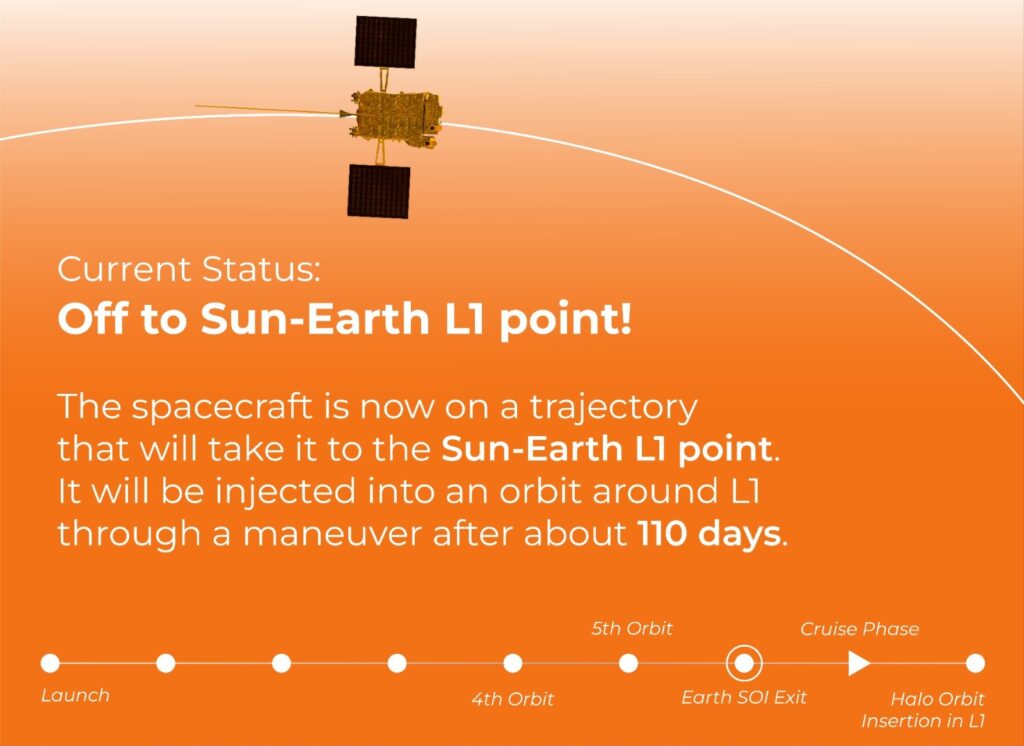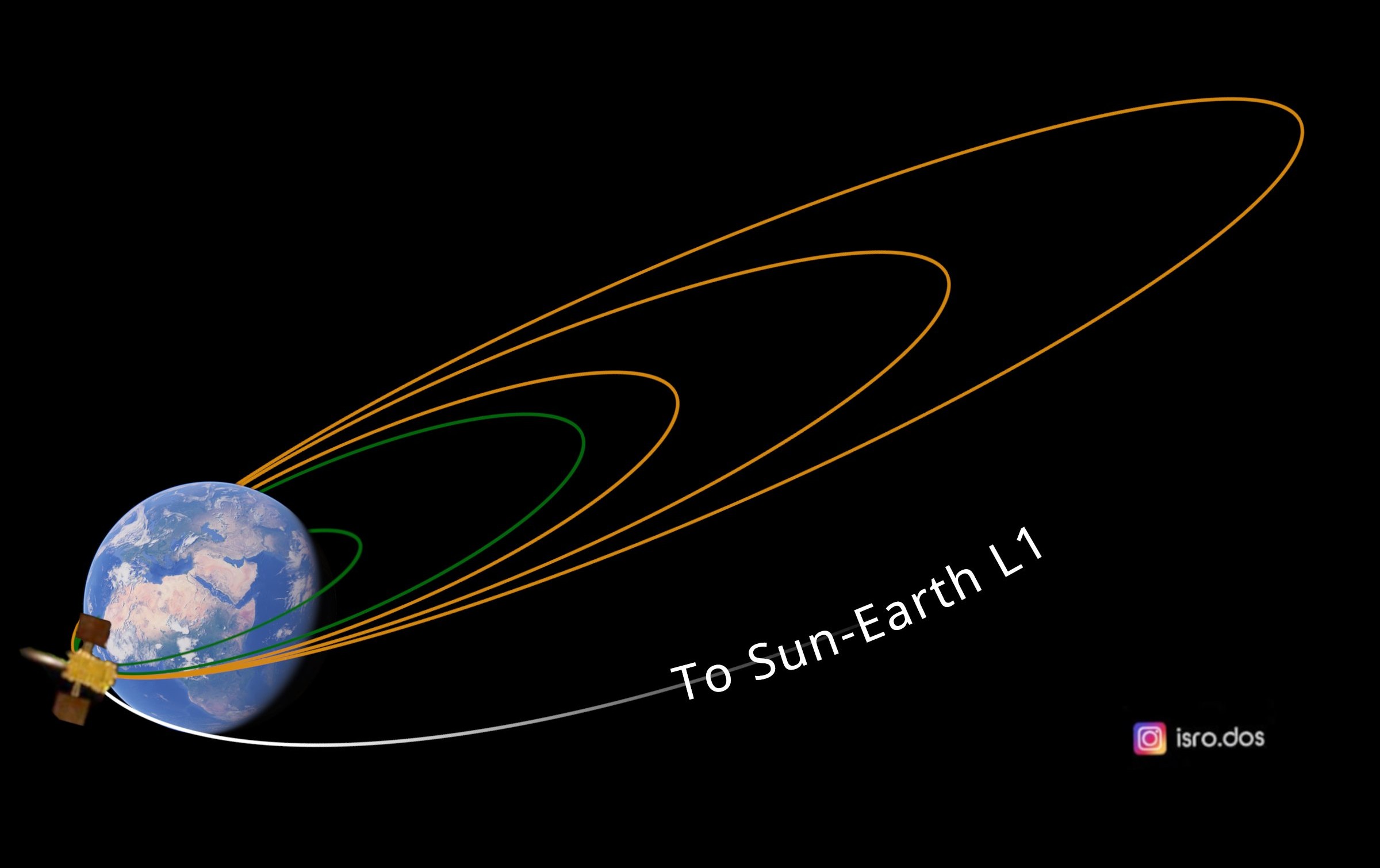Aditya L1 towards final destination, know updates about Aditya L1, Date of final reach at L1 point
The Aditya-L1 spacecraft, which was launched on September 2, 2023, is currently traveling through space on its way to the Lagrange Point 1 (L1), which is 1.5 million kilometers away from Earth and pointed in the direction of the Sun. The spacecraft recently achieved a significant milestone by leaving the influence of Earth, and is now traveling to L1. Here are some noteworthy mission updates:
Direction of L1
Aditya-L1 made its final orbit of the Earth on September 19, 2023, in order to escape the gravity of our planet and begin its ascent to L1.
Course-correction Technique
A Trajectory Correction Maneuver (TCM), lasting only 16 seconds, was carried out on October 6. The spacecraft’s trajectory needed to be adjusted using this TCM in order to follow the Trans-Lagrangean Point 1 Insertion (TL1I) maneuver conducted on September 19.
Aditya-L1 is now traveling in the direction of the Halo orbit insertion around L1 as planned. The spacecraft is operational and in good shape.
Scientific Information
The expedition has started gathering important scientific data. As Aditya-L1 continues its trip, the magnetometer will also be restarted in the upcoming days.
There are seven separate payloads on board this solar mission, all of which are intended to investigate the Sun. The remaining three payloads will measure in-situ parameters of the plasma and magnetic fields, while the last four payloads will study sunlight.
Understanding the physics of the solar corona, its heating mechanisms, solar wind acceleration, solar atmosphere dynamics, solar wind distribution, and the causes of solar flares and CMEs (coronal mass ejections), as well as their effects on near-Earth space weather, are the main goals of this mission.
Final Destination
On January 6, 2024, the Aditya-L1 mission will be positioned in a halo orbit around Earth at L1 and should have traveled four months to its observation point at L1.
Aditya-L1 by the Indian Space Research Organization (ISRO) is a ground-breaking solar mission that provides a singular vantage point for ongoing solar monitoring. The results of this trip will help us comprehend our Sun, which has a profound impact on our planet and the broader solar system.
Aditya-L1, India’s orbiting solar observatory, marked a historic milestone when ISRO carried out a crucial maneuver for its departure from Earth. This represents a significant development in the mission’s quest to solve the Sun’s secrets.After successfully completing four Earth-bound maneuvers, Aditya-L1 left earth orbit, which was launched on September 2, started its voyage to the Sun-Earth Lagrange point 1 (L1).
On September 19 at around 2:00 am IST, the spacecraft began its Trans-Lagrangian Point 1 Insertion (TL1I), which marked the start of its roughly 110-day voyage.
Aditya-L1 will have a continuous view of the Sun from the L1 point, located roughly 15 lakh kilometers from Earth. This special location will make it possible to continuously observe the dynamics of space weather as well as the photosphere, chromosphere, and corona of the Sun.
Aditya-L1 is outfitted with seven research payloads created by national research labs and ISRO. Three of these payloads will do in-situ research on particles and fields near the L1 point, while the other four will study the Sun directly. These tools will offer priceless insights on a range of solar phenomena.
Probing Particle Behavior
India’s first solar space observatory mission, Aditya-L1, has initiated the collection of scientific data as one of its instruments, known as STEPS (Supra Thermal & Energetic Particle Spectrometer), was activated by ISRO. The STEPS instrument is now measuring supra-thermal and energetic ions and electrons at distances exceeding 50,000 km from Earth. This data is vital for scientists to analyze the behavior of particles in Earth’s vicinity, offering insights into various space phenomena. STEPS is a component of the Aditya Solar Wind Particle EXperiment (ASPEX) payload.

Aditya-L1 will gradually leave the gravitational pull of Earth as it begins its trip towards L1, commencing the cruise phase. It will eventually be situated in a wide halo orbit around L1. From launch to L1, the mission will have traveled approximately four months.
Aditya-L1 has accomplished much with the TL1I maneuver, and it now opens the door for ground-breaking research into the Sun and how it affects our space environment. As our expedition continues to explore the sun, check back for additional updates.

